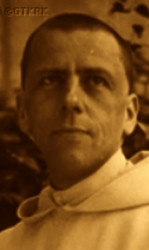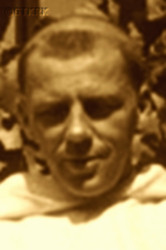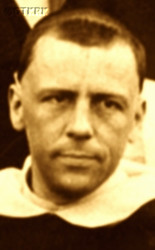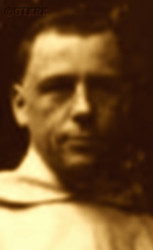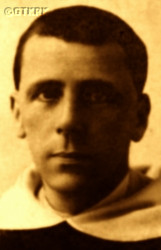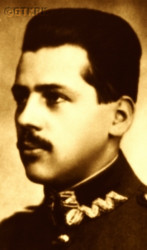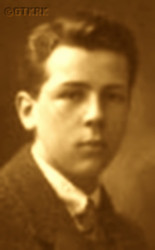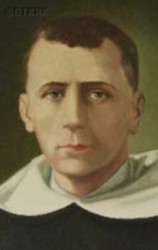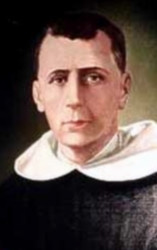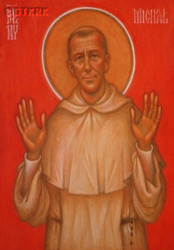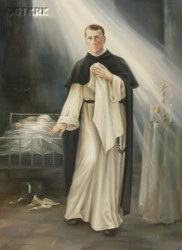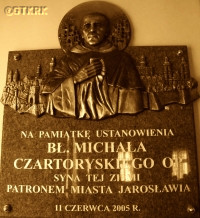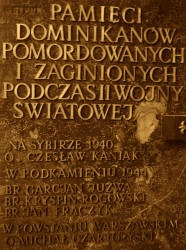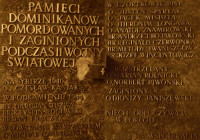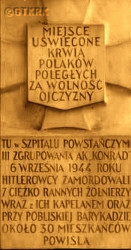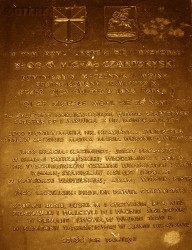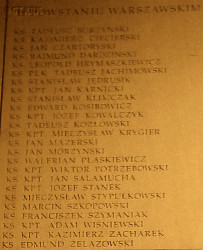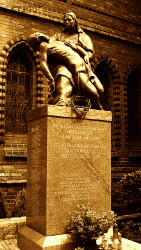Roman Catholic
St Sigismund parish
05-507 Słomczyn
85 Wiślana Str.
Konstancin deanery
Warsaw archdiocese, Poland
full list:
displayClick to display full list

searchClick to search full list by categories
wyświetlKliknij by wyświetlić pełną listę po polsku

szukajKliknij by przeszukać listę wg kategorii po polsku

Martyrology of the clergy — Poland
XX century (1914 – 1989)
personal data
religious status
blessed
surname
CZARTORYSKI
forename(s)
John Baptist Francis (pl. Jan Chrzciciel Franciszek)
religious forename(s)
Michael (pl. Michał)
beatification date
13.06.1999more on
www.swzygmunt.knc.pl
[access: 2013.05.19]

the RC Pope John Paul IImore on
en.wikipedia.org
[access: 2014.09.21]
function
religious cleric
creed
Latin (Roman Catholic) Church RCmore on
en.wikipedia.org
[access: 2014.09.21]
congregation
Order of Preachers OPmore on
en.wikipedia.org
[access: 2013.07.06]
(i.e. Dominican Order, Dominicans)
diocese / province
St Hyacinth Polish Province
RC Military Ordinariate of Polandmore on
en.wikipedia.org
[access: 2014.12.20]
academic distinctions
Architecture Engineering MA
honorary titles
„Medal of Independence”more on
en.wikipedia.org
[access: 2019.02.02]
(04.11.1933)
„Cross of Valour”more on
en.wikipedia.org
[access: 2019.04.16]
date and place
of death
06.09.1944

Warsawtoday: Warsaw city pov., Masovia voiv., Poland
more on
en.wikipedia.org
[access: 2021.10.09]
details of death
During the Polish–Ukrainian war of 1918‐1919, defender of Lviv against Ukrainian onslaught (one of the „Lviv Eaglets”) — adjutant to the commander of the Lviv Rifle Brigade.
Then, after the relief of Lviv (22.05.1919), until 16.07.1919, participant — as a field orderly — of the Polish offensive against Ukrainians that ended on the line of the Zbruch River.
From 25.07.1920, during the Polish–Russian war of 1919‐1921, a volunteer (prob.) of the Lesser Poland Volunteer Army Units of the Polish Army.
Took part — together with his three brothers — in the successful defense of Lviv against the advancing Russian Rus. Первая Конная армия (Eng. 1st Cavalry Army) of General Semyon Budyonny.
In 1921, participant, as an observer, in the Polish educational action before the plebiscite on 20.03.1921 that was to decide the fate of Upper Silesia.
In 1923, 1924, 1925, 1927 and 1929 (from 1925 each time for a 2 year period) reserve chaplain of the Polish Army.
After German invasion of Poland in 09.1939 and start of the World War II moved in 1939 to Kraków following German Wehrmacht's occupation of part of Warsaw–Służew Dominicans' monastery.
Returned to Warsaw at the end of 07.1944.
After Warsaw Uprising outbreak on 01.08.1944 chaplain to the III „Conrad” unit of I Region of Śródmieście District of Polish Home Army AK (part of Polish Clandestine State).
After insurgents were defeated in Powiśle and left on 06.09.1944 the district voluntarily remained with wounded soldiers at one of the field hospitals in a basement of a tenement building.
There during a massacre of the hospital patients murdered by the Germans.
cause of death
murder
perpetrators
Germans
sites and events
Warsaw UprisingClick to display the description, GeneralgouvernementClick to display the description, Ribbentrop‐MolotovClick to display the description, Pius XI's encyclicalsClick to display the description, Silesian UprisingsClick to display the description, Polish‐Russian war of 1919‐1921Click to display the description, Polish‐Ukrainian war of 1918‐1919Click to display the description
date and place
of birth
19.02.1897

Pełkinietoday: Jarosław gm., Jarosław pov., Subcarpathia voiv., Poland
more on
en.wikipedia.org
[access: 2021.12.18]
parents
CZARTORYSKI Witold Leo
🞲 1864, Viennatoday: Vienna state, Austria
more on
en.wikipedia.org
[access: 2020.07.31] — 🕆 1945, Maków Podhalańskitoday: Maków Podhalański gm., Sucha Beskidzka pov., Lesser Poland voiv., Poland
more on
en.wikipedia.org
[access: 2021.06.07]

DZIEDUSZYCKA Hedwig
🞲 1867, Lvivtoday: Lviv urban hrom., Lviv rai., Lviv obl., Ukraine
more on
en.wikipedia.org
[access: 2022.01.16] — 🕆 1941, Pełkinietoday: Jarosław gm., Jarosław pov., Subcarpathia voiv., Poland
more on
en.wikipedia.org
[access: 2021.12.18]
baptism
03.03.1897

Jarosławtoday: Jarosław gm., Jarosław pov., Subcarpathia voiv., Poland
more on
en.wikipedia.org
[access: 2021.04.01]
Corpus Christi RC church
religious vows
25.09.1928 (temporary)
25.09.1931 (permanent)
presbyter (holy orders)
ordination
20.12.1931

Jarosławtoday: Jarosław gm., Jarosław pov., Subcarpathia voiv., Poland
more on
en.wikipedia.org
[access: 2021.04.01]
Our Lady of Sorrows RC churchmore on
pl.wikipedia.org
[access: 2016.11.06]
positions held
from 07.1944
friar — WarsawSłużew neighborhood
form.: till 1938 separate village
today: Warsaw city pov., Masovia voiv., Poland
more on
en.wikipedia.org
[access: 2021.03.16] ⋄ St Dominica monastery, Dominicans OP
1939 – 1944
friar — Krakówtoday: Kraków city pov., Lesser Poland voiv., Poland
more on
en.wikipedia.org
[access: 2021.06.07] ⋄ Holy Trinity monastery, Dominicans OP — master of novices and students/clerics of Philosophical and Theological Studies
1936 – 1939
friar — WarsawSłużew neighborhood
form.: till 1938 separate village
today: Warsaw city pov., Masovia voiv., Poland
more on
en.wikipedia.org
[access: 2021.03.16] ⋄ St Dominica monastery, Dominicans OP — architect and construction supervisor of the monastery; also: master of novices and students/clerics of Philosophical and Theological Studies, chaplain of the Third Order of Saint Dominic TOP
till 1936
friar — Krakówtoday: Kraków city pov., Lesser Poland voiv., Poland
more on
en.wikipedia.org
[access: 2021.06.07] ⋄ Holy Trinity monastery, Dominicans OP — master of novices and students/clerics of Philosophical and Theological Studies; also: chaplain of the Third Order of Saint Dominic TOP
from 1931
friar — Jarosławtoday: Jarosław gm., Jarosław pov., Subcarpathia voiv., Poland
more on
en.wikipedia.org
[access: 2021.04.01] ⋄ Blessed Virgin Mary of Sorrows monastery, Dominicans OP — tutor of novices and students/clerics
1928 – 1931
student — Krakówtoday: Kraków city pov., Lesser Poland voiv., Poland
more on
en.wikipedia.org
[access: 2021.06.07] ⋄ Philosophical and Theological Studies, Holy Trinity monastery, Dominicans OP
18.09.1927 – 1928
novitiate — Krakówtoday: Kraków city pov., Lesser Poland voiv., Poland
more on
en.wikipedia.org
[access: 2021.06.07] ⋄ Holy Trinity monastery, Dominicans OP
1927
accession — Krakówtoday: Kraków city pov., Lesser Poland voiv., Poland
more on
en.wikipedia.org
[access: 2021.06.07] ⋄ Holy Trinity monastery, Dominicans OP
1926 – 1927
student — Lvivtoday: Lviv urban hrom., Lviv rai., Lviv obl., Ukraine
more on
en.wikipedia.org
[access: 2022.01.16] ⋄ philosophy and theology, Metropolitan Theological Seminary
1917 – 1926
student — Lvivtoday: Lviv urban hrom., Lviv rai., Lviv obl., Ukraine
more on
en.wikipedia.org
[access: 2022.01.16] ⋄ Architecture Department, Lviv Polytechnic [i.e. Lviv Polytechnic (1919‐1939) / Polytechnical School (till 1918)] — studies with interruptionis due to the wars of the reborn Poland borders in the years 1918‐21, crowned with a master's degree
co‐founder of the Lviv branch of the Association of Catholic Academic Youth „Revival” (27.10.1921), first president of „Revival”, member of the national main Audit Committee of „Revival” (from 09.1925), first president of the „Union of Christ Knights of St Dominic”, known also as „Retreat Association of St Dominic” (founded on 02.08.1922)
sites and events
descriptions
Warsaw Uprising: Lasted from 01.08.1944 till 03.10.1944. Was an attempt to liberate Polish capital from occupying Germans by the Polish Clandestine State — a unique in the history of the world political structure on the territories occupied by the Germans, effectively governing clandestinely in Poland — and by fighting on its behalf underground military units, mainly of Home Army (former Armed Struggle Association ZWZ) and National Armed Forced (NSZ). At the same time Russians stopped on purpose the offensive on all front, halted on the other bank of Vistula river and watched calmly the annihilation of the city, refusing even the mid‐landing rights to the Allied planes carrying weapons and supplies to the insurgents from Italy. During the Uprising Germans murdered approx. 200,000 Poles, mainly civilians. Approx. 200 priests and nuns died in fighting or were murdered by the Germans, many in mass executions. (more on: en.wikipedia.orgClick to attempt to display webpage
[access: 2013.08.17])
Generalgouvernement: After the Polish defeat in the 09.1939 campaign, which was the result of the Ribbentrop‐Molotov Pact and constituted the first stage of World War II, and the beginning of German occupation in part of Poland (in the other, eastern part of Poland, the Russian occupation began), the Germans divided the occupied Polish territory into five main regions. In two of them new German provinces were created, two other were incorporated into other provinces. However, the fifth part was treated separately, and in a political sense it was supposed to recreate the German idea from 1915 (during World War I, after the defeat of the Russians in the Battle of Gorlice in 05.1915) of creating a Polish enclave within Germany. Illegal in the sense of international law, i.e. Hague Convention, and public law, managed by the Germans according to separate laws — especially established for the Polish Germ. Untermenschen (Eng. subhumans) — till the Russian offensive in 1945 it constituted part of the Germ. Großdeutschland (Eng. Greater Germany). Till 31.07.1940 formally called Germ. Generalgouvernement für die besetzten polnischen Gebiete (Eng. General Government for the occupied Polish lands) — later simply Germ. Generalgouvernement (Eng. General Governorate), as in the years 1915‐1918. From 07.1941, i.e. after the German attack on 22.06.1941 against the erstwhile ally, the Russians, it also included the Galicia district, i.e. the Polish pre‐war south‐eastern voivodeships. A special criminal law was enacted and applied to Poles and Jews, allowing for the arbitrary administration of the death penalty regardless of the age of the „perpetrator”, and sanctioning the use of collective responsibility. After the end of the military conflict of the World War UU, the government of the Germ. Generalgouvernement was recognized as a criminal organization, and its leader, governor Hans Frank, guilty of war crimes and crimes against humanity and executed. (more on: en.wikipedia.orgClick to attempt to display webpage
[access: 2024.12.13])
Ribbentrop‐Molotov: Genocidal Russian‐German alliance pact between Russian leader Joseph Stalin and German leader Adolf Hitler signed on 23.08.1939 in Moscow by respective foreign ministers, Mr. Vyacheslav Molotov for Russia and Joachim von Ribbentrop for Germany. The pact sanctioned and was the direct cause of joint Russian and German invasion of Poland and the outbreak of the World War II in 09.1939. In a political sense, the pact was an attempt to restore the status quo ante before 1914, with one exception, namely the „commercial” exchange of the so‐called „Kingdom of Poland”, which in 1914 was part of the Russian Empire, fore Eastern Galicia (today's western Ukraine), in 1914 belonging to the Austro‐Hungarian Empire. Galicia, including Lviv, was to be taken over by the Russians, the „Kingdom of Poland” — under the name of the General Governorate — Germany. The resultant „war was one of the greatest calamities and dramas of humanity in history, for two atheistic and anti‐Christian ideologies — national and international socialism — rejected God and His fifth Decalogue commandment: Thou shall not kill!” (Abp Stanislav Gądecki, 01.09.2019). The decisions taken — backed up by the betrayal of the formal allies of Poland, France and Germany, which on 12.09.1939, at a joint conference in Abbeville, decided not to provide aid to attacked Poland and not to take military action against Germany (a clear breach of treaty obligations with Poland) — were on 28.09.1939 slightly altered and made more precise when a treaty on „German‐Russian boundaries and friendship” was agreed by the same murderous signatories. One of its findings was establishment of spheres of influence in Central and Eastern Europe and in consequence IV partition of Poland. In one of its secret annexes agreed, that: „the Signatories will not tolerate on its respective territories any Polish propaganda that affects the territory of the other Side. On their respective territories they will suppress all such propaganda and inform each other of the measures taken to accomplish it”. The agreements resulted in a series of meeting between two genocidal organization representing both sides — German Gestapo and Russian NKVD when coordination of efforts to exterminate Polish intelligentsia and Polish leading classes (in Germany called «Intelligenzaktion», in Russia took the form of Katyń massacres) where discussed. Resulted in deaths of hundreds of thousands of Polish intelligentsia, including thousands of priests presented here, and tens of millions of ordinary people,. The results of this Russian‐German pact lasted till 1989 and are still in evidence even today. (more on: en.wikipedia.orgClick to attempt to display webpage
[access: 2015.09.30])
Pius XI's encyclicals: Facing the creation of two totalitarian systems in Europe, which seemed to compete with each other, though there were more similarities than contradictions between them, Pope Pius XI issued in 03.1937 (within 5 days) two encyclicals. In the „Mit brennender Sorge” (Eng. „With Burning Concern”) published on 14.03.1938, condemned the national socialism prevailing in Germany. The Pope wrote: „Whoever, following the old Germanic‐pre‐Christian beliefs, puts various impersonal fate in the place of a personal God, denies the wisdom of God and Providence […], whoever exalts earthly values: race or nation, or state, or state system, representatives of state power or other fundamental values of human society, […] and makes them the highest standard of all values, including religious ones, and idolizes them, this one […] is far from true faith in God and from a worldview corresponding to such faith”. On 19.03.1937, published „Divini Redemptoris” (Eng. „Divine Redeemer”), in which criticized Russian communism, dialectical materialism and the class struggle theory. The Pope wrote: „Communism deprives man of freedom, and therefore the spiritual basis of all life norms. It deprives the human person of all his dignity and any moral support with which he could resist the onslaught of blind passions […] This is the new gospel that Bolshevik and godless communism preaches as a message of salvation and redemption of humanity”… Pius XI demanded that the established human law be subjected to the natural law of God , recommended the implementation of the ideal of a Christian state and society, and called on Catholics to resist. Two years later, National Socialist Germany and Communist Russia came together and started World War II. (more on: www.vatican.vaClick to attempt to display webpage
[access: 2023.05.28], www.vatican.vaClick to attempt to display webpage
[access: 2023.05.28])
Silesian Uprisings: Three armed interventions of the Polish population against Germany in 1919‐1921 aiming at incorporation of Upper Silesia and Opole region into Poland, after the revival of the Polish state in 1918. Took place in the context of a plebiscite ordered on the basis of the international treaty of Versailles of 28.06.1919, ending the First World War, that was to decide national fate of the disputed lands. The 1st Uprising took place on 16‐24.08.1919 and broke out spontaneously in response to German terror and repression against the Polish population. Covered mainly Pszczyna and Rybnik counties and part of the main Upper Silesia industrial district. Suppressed by the Germans. 2nd Uprising took place on 19‐25.08.1920 in response to numerous acts of terror of the German side. Covered the entire area of the Upper Silesia industrial district and part of the Rybnik county. As a result Poles obtained better conditions for the campaign prior the plebiscite. The poll was conducted on 20.03.1921. The majority of the population — 59.6% — were in favor of Germany, but the results were influenced by the admission of voting from former inhabitants of Upper Silesia living outside Silesia. As a result the 3rd Uprising broke out, the largest such uprising of the Silesian in the 20th century. It lasted from 02.05.1921 to 05.07.1921. Spread over almost the entire area of Upper Silesia. Two large battles took place in the area of St. Anna Mountain and near Olza. As a result on 12.10.1921 the international plebiscite commission decided on a more favorable for Poland division of Upper Silesia. The territory granted to Poland was enlarged to about ⅓ of the disputed territory. Poland accounted for 50% of metallurgy and 76% of coal mines. (more on: en.wikipedia.orgClick to attempt to display webpage
[access: 2020.05.25])
Polish‐Russian war of 1919‐1921: War for independence of Poland and its borders. Poland regained independence in 1918 but had to fight for its borders with former imperial powers, in particular Russia. Russia planned to incite Bolshevik‐like revolutions in the Western Europe and thus invaded Poland. Russian invaders were defeated in 08.1920 in a battle called Warsaw battle („Vistula river miracle”, one of the 10 most important battles in history, according to some historians). Thanks to this victory Poland recaptured part of the lands lost during partitions of Poland in XVIII century, and Europe was saved from the genocidal Communism. (more on: en.wikipedia.orgClick to attempt to display webpage
[access: 2014.12.20])
Polish‐Ukrainian war of 1918‐1919: One of the wars for borders of the newly reborn Poland. At the end of 1918 on the former Austro‐Hungarian empire’s territory, based on the Ukrainian military units of the former Austro‐Hungarian army, Ukrainians waged war against Poland. In particular attempted to create foundation of an independent state and attacked Lviv. Thanks to heroic stance of Lviv inhabitants, in particular young generation of Poles — called since then Lviv eaglets — the city was recaptured by Poles and for a number of months successfully defended against furious Ukrainian attacks. In 1919 Poland — its newly created army — pushed Ukrainian forces far to the east and south, regaining control over its territory. (more on: en.wikipedia.orgClick to attempt to display webpage
[access: 2017.05.20])
sources
personal:
swzygmunt.knc.plClick to attempt to display webpage
[access: 2012.11.23]
original images:
www.youtube.comClick to attempt to display webpage
[access: 2016.11.06], jaroslaw.dominikanie.plClick to attempt to display webpage
[access: 2016.11.06], www.czartoryski.dominikanie.plClick to attempt to display webpage
[access: 2016.11.06], blogmedia24.plClick to attempt to display webpage
[access: 2013.05.19], www.czartoryski.dominikanie.plClick to attempt to display webpage
[access: 2016.11.06], www.czartoryski.dominikanie.plClick to attempt to display webpage
[access: 2016.11.06], www.sluzew.dominikanie.plClick to attempt to display webpage
[access: 2016.11.06], wygarki.przemyska.plClick to attempt to display webpage
[access: 2016.11.06], www.alexiagb.plClick to attempt to display webpage
[access: 2016.11.06], www.youtube.comClick to attempt to display webpage
[access: 2016.11.06], rytdominikanski.plClick to attempt to display webpage
[access: 2016.11.06], www.sluzew.dominikanie.plClick to attempt to display webpage
[access: 2016.11.06], www.panoramio.comClick to attempt to display webpage
[access: 2016.11.06], www.czartoryski.dominikanie.plClick to attempt to display webpage
[access: 2016.11.06], naszepogorze.blogspot.comClick to attempt to display webpage
[access: 2016.11.06], www.katedrapolowa.plClick to attempt to display webpage
[access: 2014.01.16], www.szczecin.plClick to attempt to display webpage
[access: 2014.09.21]
LETTER to CUSTODIAN/ADMINISTRATOR
If you have an Email client on your communicator/computer — such as Mozilla Thunderbird, Windows Mail or Microsoft Outlook, described at WikipediaPatrz:
en.wikipedia.org, among others — try the link below, please:
LETTER to CUSTODIAN/ADMINISTRATORClick and try to call your own Email client
If however you do not run such a client or the above link is not active please send an email to the Custodian/Administrator using your account — in your customary email/correspondence engine — at the following address:

giving the following as the subject:
MARTYROLOGY: CZARTORYSKI John Baptist Francis
To return to the biography press below:
 Click to return to biography
Click to return to biography








